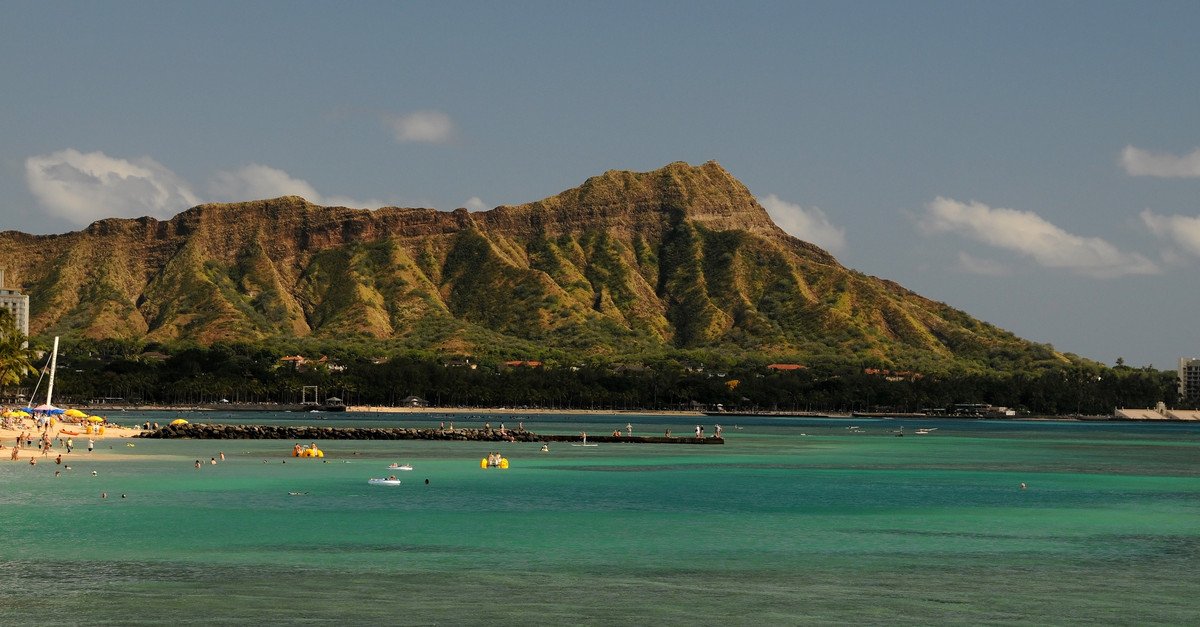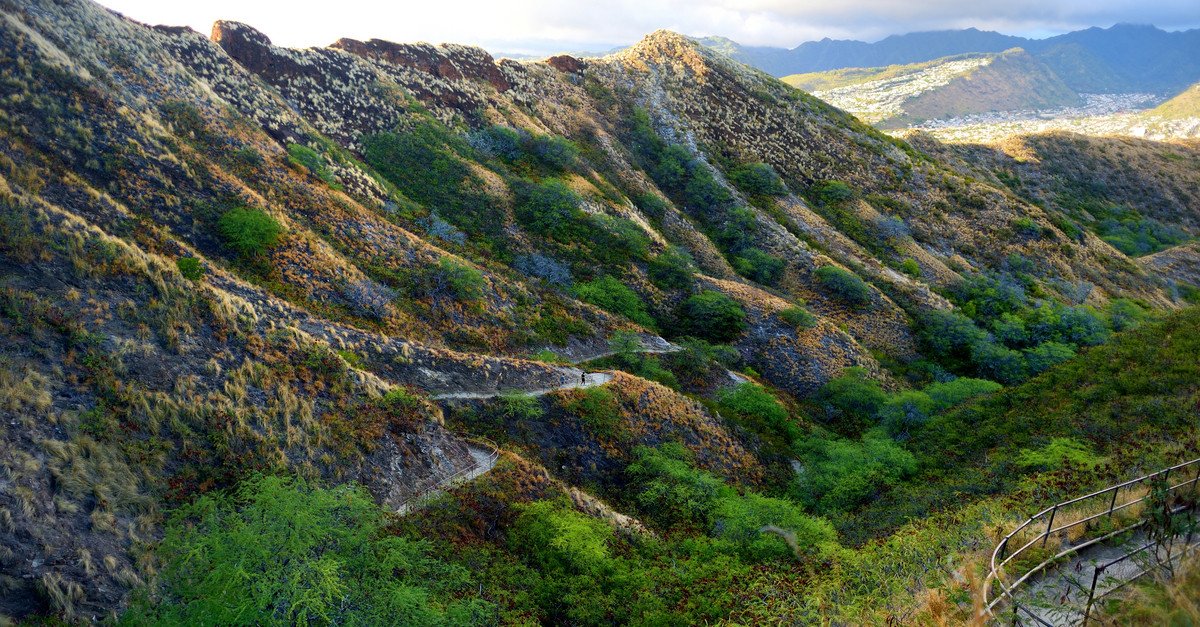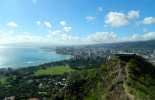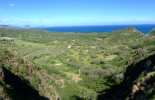07-26-2025
Diamond Head State Monument
Located within the Waikiki & Honolulu Region on Oahu
Aloha! This article may link to trusted Hawaii resources (like Discount Hawaii Car Rentals) at no extra cost to you. Mahalo for your support!
Oahu Must See & Do
Oahu Parks
Diamond Head State Monument is located just east of Waikiki, on the island of Oahu, and is the most recognized landmark in Hawaii.
The area has been shaped by a dynamic geological history. The creation of the island of Oahu began about 2.5 to 4 million years ago with volcanic eruptions from 2 shield volcanoes, and the Ko’olau and Wai’anae Mountain ranges are the eroded remnants. The area was inactive for 1.3 million years and then the southeastern end of the Ko’olau range erupted, resulting in the formation of rock called tuff cones such as Diamond Head.
Known to Hawaiian people as Le’ahi, its name is derived from the words lae meaning ‘forehead’ and ahi ‘tuna’, as the ridgeline is said to resemble a forehead of a tuna. British sailors gave it its more widely-known name by mistaking quartz crystals in the rock for diamonds. It is believed that Le’ahi was formed about 300,000 years ago during that brief, single eruption. The crater has been extinct for 150,000 years and covers 350 acres. Since the eruption that formed it, the slopes of the crater have been eroded and weathered by rain, wind, and ocean waves.

Diamond Head Crater is a must see and do while on Oahu
Non-Resident Fees
As of April 19, 2021, All non-Hawaii resident visitors to Diamond Head State Monument will now be required to purchase both Entrance and Parking unless arriving on-foot. Children 3 and under are free. Parking and Entry for Hawaii residents is free with Hawaii ID or Hawaii Driver License. Paid Entry and Parking by CREDIT CARD ONLY,
Entry fee (non-resident): $5 per person.
Parking fee (non-resident): $10 per vehicle.
Non-Resident Reservations Now Required
The State of Hawaii's Department of Land and Natural Resources (DLNR) has announced, that as of May 12, 2022, advanced reservations will be required for out-of-state visitors at Le'ahi - Diamond Head State Monument.
The implementation of this system delivers on one of the top priorities of the community as articulated in the updated Oahu Destination Management Action Plan. The new reservation system will mitigate environmental impacts sustained by foot traffic, reduce vehicle congestion in the park and surrounding neighborhoods, improve the experience of kama'aina and visitors enjoying the monument, and help preserve this landmark for future generations.
Visitors parking vehicles in the crater will be required to book in two-hour time slots beginning at 6 a.m. (two consecutive slots can be booked). Walk-in and drop-off visitors will be subject to one-hour entry time slots. Arrival and exit times will be enforced to assure adequate turnover to allow for later arrivals. Park hours and visitor entrance fees are available at Hawaii DLNR.
Historically, the summit has always been used for navigation: another translation of Le’ahi is ‘fire headland’, which refers to navigational fires that were lit to guide canoes traveling along the shoreline in ancient times. The heiau (Hawaiian temple) built on the summit was dedicated to the god of wind as protection against updrafts that could put out the fires. Little evidence of the heiau exists today, but structures from more recent defense strategies still stand.
Diamond Head was selected as a fortification because the crater walls are a natural defense from the summit, and ships can be seen from Koko Head to Pearl Harbor. From Fort Ruger to the Fire Control Station, Diamond Head is dotted with bunkers that were built to defend Oahu from attack leading up to WWI and WWII. Fortification began in 1908 with the construction of gun placements and an entry tunnel through the north wall of the crater known as the Kapahulu Tunnel. The Fire Control Station was built sometime between 1908-1910 and its purpose was to view potential sea and air attacks.
Le’ahi is a place that offers respite from the busy highways of Honolulu. The drive around Diamond Head is quite picturesque, as it winds around the crater by the ocean. The Diamond Head Lighthouse can also be seen from the road. Once you enter through the tunnel that bores into the side of the crater, it feels like a world away from the city. There is a lovely patch of shady trees and green grass to rest and picnic at the start of the trailhead.
The monument is a very popular tourist attraction, offering informative signs, bathrooms, and a shave ice and smoothie truck during opening hours.

Trails leading to the top of Diamond Head State Monument
Once you leave the shade of the trees near the parking lot, the Diamond Head Hiking Trail is a very exposed and dry area. The semi-arid climate and steep rocky slopes as well as shallow soil support only low shrubs and herbs. In the rainy season, the crater floor will transform into a wetland due to the low permeability of the tuff soils. Most plants in the area are introduced, including the abundant koa haole, which was brought in as cattle feed in the 1800’s. It is ideal to hike the trail early in the morning (between 6-8 am) to avoid the inevitable scorch of the sun and the flood of tourists that frequent the area every day.
From the trailhead to the summit of Diamond Head Crater, it is 0.8miles (1.3km) one way and it is a 560 foot (171m) climb from the crater floor. Allow 1.5 to 2 hours for a safe and leisurely round-trip hike. The trail follows an uneven and, at times, steep terrain and appropriate footwear is required. The hike begins as a concrete pathway then becomes a dirt path about halfway. Initially, the well-paved trail winds its way through spindly haole koa forest until the base of a set of switchbacks where you can begin to see views of the crater.
At the top of the first tunnel, you can follow a steep set of stairs into the base of the Fire Control Station and then up the spiral staircase to the top. Alternatively, you can follow the path to the left and up a slightly more gradually inclining staircase to the top where there are fabulous views of Hawaii Kai towards Makapu’u. Then follow another stairway to end up at the same final destination as the other route, with extensive views of Waikiki, Honolulu, and surrounding neighborhoods.
The summit offers stunning panoramic views of Oahu’s southeastern coastline towards Koko Head and the offshore islands of Molokai, Lanai, and Maui. Elevation at the summit is 761 feet (232m).
Directions to Diamond Head
Exit Waikiki and travel to Diamond Head (east) on Kalakaua Avenue. As you cross Kapahulu Avenue continue straight, then take the left fork, which is Monsarrat Avenue. Continue straight until it becomes Diamond Head Road. The access road to Diamond Head crater will be on your right, just across from Kapiolani Community College.

Follow the trail to the summit of Diamond Head Crater
Our Oahu Tour Recommendations
Oahu is the perfect place for a Hawaiian vacation. Whether you're an adrenaline junkie looking for a thrill, a history buff eager learn more, a yogi or yogini yearning to deepen your practice, or simply want to sit back and enjoy the view on a guided tour, these Oahu adventures are sure to please.
Diamond Head State Monument (Leahi) - Honolulu Reviews
Guidereview:
A (based on 10,664 visitor reviews)Geolocation Data
Geographic Coordinates
Latitude: 21.263480734782
Longitude: -157.80501512748
Hawaii Safety Information
Diamond Head State Monument Photo Gallery




Recommended Tours Nearby
Affiliate Disclosure: We may earn commissions from some travel partners (like Amazon or Expedia) which helps us maintain this site. These links are at no extra cost to you and don't impact our honest & unbiased recommendations. Remove all the ads →







